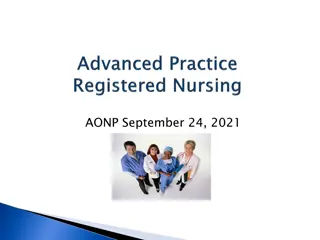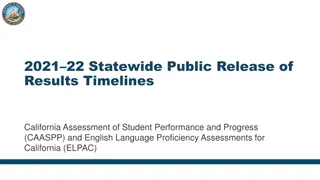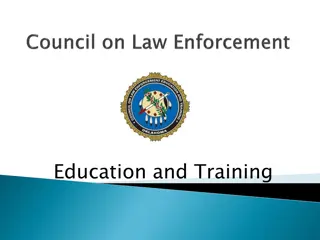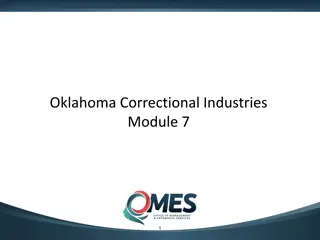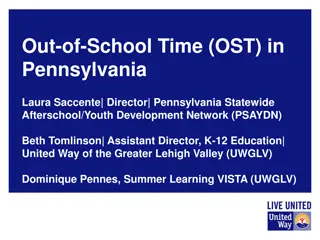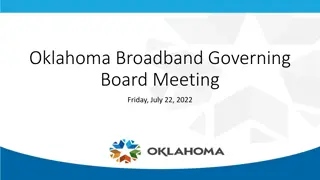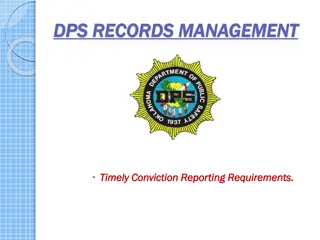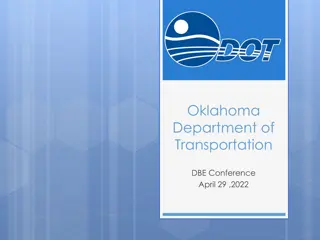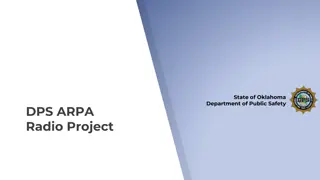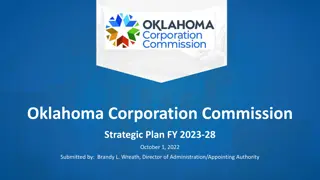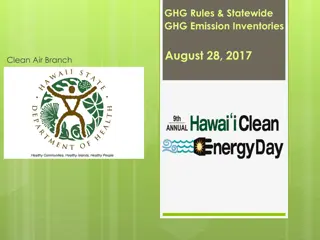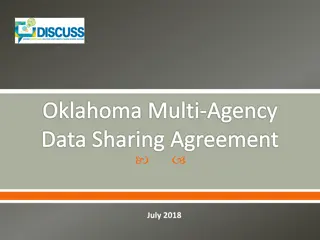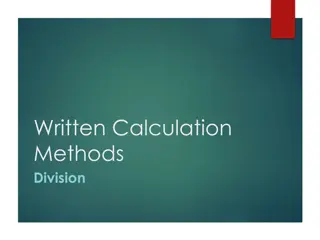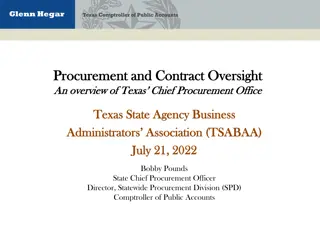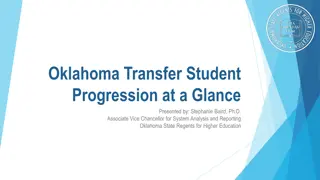Prevention Division: Enhancing Statewide Prevention Efforts in Oklahoma
Sustainable, evidence-based prevention efforts are crucial in Oklahoma, with concerning data on underage drinking, alcohol-related consequences, and drug consumption. The state aims to create a healthier future by addressing these issues strategically and collaboratively.
Uploaded on Oct 03, 2024 | 0 Views
Download Presentation

Please find below an Image/Link to download the presentation.
The content on the website is provided AS IS for your information and personal use only. It may not be sold, licensed, or shared on other websites without obtaining consent from the author. Download presentation by click this link. If you encounter any issues during the download, it is possible that the publisher has removed the file from their server.
E N D
Presentation Transcript
Prevention Division Strategic Prevention Enhancement Planning March 2012
Prevention Division Mission To implement and sustain comprehensive, statewide prevention efforts that are evidence-based and accountable to the state s citizens, encourage the collaboration of multiple agencies and organizations, and enhance the capacity of communities to provide an effective and comprehensive system of prevention services reflective of community needs and resources. Vision A future for Oklahoma in which every citizen is provided the opportunity to achieve a state of health and well-being free from the scourge of mental, emotional, and behavioral disorders.
Underage Drinking In 2009, among 9th to 12th grade Oklahoma public high school students 71% had at least one drink during their life. 19% had their first drink of alcohol before the age of 13. 39% had at least one drink during the last 30 days. 11% drove a vehicle while drinking during the past 30 days. 24% of students had 5 or more drinks of alcohol in a row, that is, within a couple of hours, one or more of the past 30 days.
Alcohol Consequences Oklahoma is consistently above the national average in crimes related to alcohol. Since 2003, there has been an 18.1% increase in aggravated assaults, sexual assaults, and robberies. (UCR) Oklahoma is consistently above the national average in alcohol- related mortality. In 2009, 11% of Oklahoma s adolescents drove while drinking, 13% higher than the national average (YRBS).
Drug Consumption Oklahoma ranks number one for the non-medical use of pain relievers in the past year in all age categories: 12+, 12-17, 18-25 and 26+. (NSDUH, 2009) Adolescent use of inhalants is on a steady ascent. In 2009, 12.7 percent of Oklahoma adolescents reported inhalant use, surpassing the national average of 11.7 percent. (YRBS) Oklahoma has been consistently above the national average among persons aged 12 and older reporting the use of any illicit drug other than marijuana. (NSDUH) Oklahoma exceeds the national average in adolescent methamphetamine, cocaine, ecstasy, steroid, and inhalant use. (YRBS, 2009) Since 2003, the percentage of youth methamphetamine users in grades 9-12 has dropped by half. (YRBS)
Drug Consequences In 2007, the rate per 100,000 of deaths due to drug poisonings was 19.1 for Oklahoma and 11.9 for the Nation as a whole. (NVSS) In 2009, Oklahoma reported 3573.8 per 100,000 property crimes compared to the national rate of 3036.1 per 100,000. (UCR) There has been a 210 percent increase in opiate-related deaths in Oklahoma since 1999. (NVSS) Oklahoma ranked 4th in the Nation for opiate overdoes deaths, exceeding the national average by 123 percent. (NCHS) NVSS 1999-2007 Opioid Overdose Deaths Per 100,000 Population
Where to Get Data Oklahoma Data Query System To provide communities and agencies with easy access to available alcohol, tobacco, and other drug consumption and consequence data. http://indicators.bachharrison.com/okdataqu erysystem
What is Prevention? Prevention is viewed as a proactive process by which conditions that promote wellbeing are created; empower individuals and communities to meet the challenges of life events and transitions by creating conditions and reinforcing individual and collective behaviors that lead to healthy communities and lifestyles.
What is the Environmental Approach to Prevention? Strategies that aim to decrease social and health consequences of substance abuse by limiting access to substances and changing social norms that are accepting and permissive of substance abuse. How? By changing public laws, policies and practices to create environments that decrease the probability of substance abuse.
Environmental Prevention Focuses on Community Risk Why focus on the environment? Has not traditionally been addressed Costs less inexpensive Changes the culture/what s acceptable and normal Impacts more people for the long term
Causal/Contributing Factors Factors that have been identified as being strongly related to and influence the occurrence and magnitude of substance use and its consequences. SCIENTIFIC KNOWLEDGE ABOUT PREVENTION STRATEGIES SUBSTANCE USE and RELATED CONSEQUENCES Causal Variables
Variables Availability Economic Availability - Price Retail Availability - ATOD accessibility from retail sources (money is exchanged). Social Availability ATOD accessibility from non-retail sources (money rarely exchanged -- family and friends). Promotion- Attempts to increase the attractiveness of drinking, smoking or using illicit drugs and/or the substances themselves
Variables Norms - Informal standards or values regarding the acceptability or unacceptability of certain behaviors, including substance use. Enforcement - Of laws and regulations beyond the passage of the law. Individual characteristics - Values, attitudes, and social associations that influence individual decisions to use
Economic Availability (Price) ALCOHOL: Higher alcohol prices are associated both with less alcohol consumption and fewer associated problems Studies have found increased price leads to decreased alcohol-related problems TOBACCO: Higher tobacco prices are associated both with less consumption and fewer associated problems Studies have found that increased price leads to decreased tobacco use (cigarettes and smokeless) ILLICIT DRUGS: Higher illicit drug prices are associated with reduced consumption Studies have found that an increase in price yields decreased use of marijuana, cocaine, and heroin
Retail Availability ALCOHOL: Specific efforts to reduce retail availability have found reduced retail availability results in lower alcohol consumption and associated problems (all ages) TOBACCO: Local efforts have demonstrated that efforts to enact and enforce underage tobacco laws can reduce the retail sales rate of tobacco (studies focus on youth) ILLICIT DRUGS: Few studies have examined relationship between efforts to change the retail availability of illicit drugs and use or associated problems. Evidence suggests can at minimum move retail markets.
Social Availability ALCOHOL: Majority of alcohol consumed by youth is obtained through social sources Worldwide, 1/3-2/3 of drunk driving offenders had last drink in unlicensed premise (e.g., home, party) Little intervention data are available TOBACCO: Most common sources of cigarettes by youth are gifts, borrowing, or stealing from family members and peers Little intervention research available ILLICIT DRUGS: Large percentage of users report obtaining drugs as gift No intervention research
Promotion ALCOHOL: Advertising is almost universal in Western countries. High recall of advertising among youth and increased exposure to alcohol ads associated with increased consumption and hazardous drinking Partial bans appear not to impact consumption; total bans show some effects on consumption and related problems TOBACCO: Advertising is almost universal in Western countries. High recall of advertising among youth increased exposure to tobacco ads associated with increased consumption Mixed findings on effects of advertising bans or restrictions ILLICIT DRUGS: Limited promotion through legal channels No studies that have examined the relationship between promotion and illicit drug use and associated problems
Community Norms ALCOHOL: Countries where drinking and/or excess drinking not sanctioned drink less than countries where use is widely sanctioned Surveys find increasing support over time for restrictions on alcohol access and use indicating a temporal change in norms as consumption declines. TOBACCO: Gender difference in smoking likely reflect social norms Surveys show increasing support over time for restrictions on tobacco access and use indicating a temporal change in norms as consumption declines. ILLICIT DRUGS: Little research exploring the influence of social norms on illicit drug use was found.
Enforcement ALCOHOL: Studies of efforts to enforce youth access and specific types of use policies find increased enforcement related to changes in use and related problems. TOBACCO: Studies of enforcement of youth access and clean air laws provide strong evidence that increases in enforcement can reduce tobacco use and problems associated with use. ILLICIT DRUGS: Marginal increases in enforcement efforts appear not to change use patterns or problems. Increased enforcement may at times produce increased use and/or problems
Why Prevention? Prevention saves money. Research indicates that for every $1 invested in prevention up to $18 can be saved. Prevention preserves public health, safety, and wellbeing. Prevention saves lives.
Oklahoma Prevention Initiatives What we do Who to contact Prevention Block Grant Stephanie U Ren Strategic Prevention Framework State Incentive Grant Young Onuorah State Epidemiology Outcomes Workgroup Jamie Piatt Adrienne Rollins Too Much To Lose David Harris Youth Suicide Prevention Lenae Clement Synar Compliance Jamie Piatt Oklahoma Prevention Needs Assessment Elicia Berryhill Oklahoma Partnership Initiative Dane Libart Mental Health First Aid Deborah Smith State Prevention Enhancement Grant http://ok.gov/odmhsas/Prevention_/Prevention_Initiatives/index.html
Prevention Takes Careful Planning Strategic Prevention Framework
State Prevention Enhancement Grant One-year cooperative agreement To strengthen and enhance current prevention infrastructure For community-oriented, evidence-based prevention services.
Populations of Focus Asian American African American Elderly Latino LGBTQ2 Low Income Military Families Native American Rural
Why We Need Your Help To help us determine: whether our substance abuse prevention services are meeting focus population s needs what data are available to help us assess, plan, support and/or deliver services that are inclusive of the focus populations what data/gaps exist what barriers exist ways to address unmet needs what additional partnerships should be developed
The Process Outcome Workgroup Meetings Facilitator (keep discussions lively and ongoing) Compile report of recommendations focused on substance abuse prevention Group leader (recruit/retain members/organize meetings) 4-5 active participating members By June 30, 2012 Note taker (record discussions) 3-4 meetings Mileage covered (if necessary) Prepared agenda
Will You Continue Meeting? The group should decide whether it is beneficial to the focus population and to the ODMHSAS to continue meeting and in what capacity (advisory, independent, etc.)
Questions Jessica Hawkins Director of Prevention Division 405-522-5952 jhawkins@odmhsas.org



